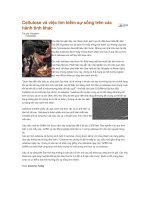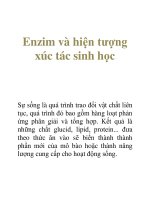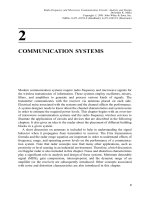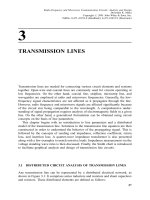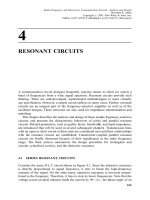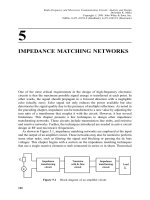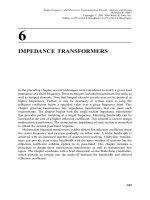Tài liệu RF và mạch lạc lò vi sóng P1 ppt
Bạn đang xem bản rút gọn của tài liệu. Xem và tải ngay bản đầy đủ của tài liệu tại đây (158.51 KB, 8 trang )
1
INTRODUCTION
Scientists and mathematicians of the nineteenth century laid the foundation of
telecommunication and wireless technology, which has affected all facets of modern
society. In 1864, James C. Maxwell put forth fundamental relations of electro-
magnetic ®elds that not only summed up the research ®ndings of Laplace, Poisson,
Faraday, Gauss, and others but also predicted the propagation of electrical signals
through space. Heinrich Hertz subsequently veri®ed this in 1887 and Guglielmo
Marconi successfully transmitted wireless signals across the Atlantic Ocean in 1900.
Interested readers may ®nd an excellent reference on the historical developments of
radio frequencies (RF) and microwaves in the IEEE Transactions on Microwave
Theory and Technique (Vol. MTT-32, September 1984).
Wireless communication systems require high-frequency signals for the ef®cient
transmission of information. There are several factors that lead to this requirement.
For example, an antenna radiates ef®ciently if its size is comparable to the signal
wavelength. Since the signal frequency is inversely related to its wavelength,
antennas operating at radio frequencies and microwaves have higher radiation
ef®ciencies. Further, their size is relatively small and hence convenient for mobile
communication. Another factor to favor RF and microwaves is that the transmission
of broadband information signals requires a high-frequency carrier signal. In the
case of a single audio channel, the information bandwidth is about 20 kHz. If
amplitude modulation is used to superimpose this information on a carrier then it
requires at least this much bandwidth on one side of the spectrum. Further,
commercial AM transmission requires a separation of 10 kHz between the two
transmitters. On the other hand, the required bandwidth increases signi®cantly if
frequency modulation is used. Each FM transmitter typically needs a bandwidth of
200 kHz for audio transmission. Similarly, each television channel requires about
1
Radio-Frequency and Microwave Communication Circuits: Analysis and Design
Devendra K. Misra
Copyright # 2001 John Wiley & Sons, Inc.
ISBNs: 0-471-41253-8 (Hardback); 0-471-22435-9 (Electronic)
6 MHz bandwidth to carry the video information as well. Table 1.1 shows the
frequency bands used for commercial radio and television broadcasts.
In the case of digital transmission, a standard monochrome television picture is
sampled over a grid of 512 Â 480 elements that are called pixels. Eight bits are
required to represent 256 shades of the gray display. In order to display motion,
30 frames are sampled per second. Thus, it requires about 59 Mb=s
(512 Â 480 Â 8 Â 30 58;982;400). Color transmission requires even higher band-
width (on the order of 90 Mb=s).
Wireless technology has been expanding very fast, with new applications
reported every day. Besides the traditional applications in communication, such as
radio and television, RF and microwave signals are being used in cordless phones,
cellular communication, LAN, WAN, MAN, and PCS. Keyless door entry, radio-
frequency identi®cation (RFID), monitoring of patients in a hospital or a nursing
home, and cordless mice or keyboards for computers are some of the other areas
where RF technology is being applied. While some of these applications have
traditionally used infrared (IR) technology, current trends are moving toward RF. The
fact is that RF is superior to infrared technology in many ways. Unlike RF, infrared
technology requires unobstructed line-of-sight connection. Although RF devices are
more expensive in comparison with IR, this is expected to change soon as their
production and use increases.
TABLE 1.1 Frequency Bands Used in Commercial Broadcasting
Channels Frequency Range Wavelength Range
AM 107 535 kHz±1605 kHz 186.92 m±560.75 m
TV 2±4 54 MHz±72 MHz 4.17 m±5.56 m
5±6 76 MHz±88 MHz 3.41 m±3.95 m
FM 100 88 MHz±108 MHz 2.78 m±3.41 m
TV 7±13 174 MHz±216 MHz 1.39 m±1.72 m
14±83 470 MHz±890 MHz 33.7 cm±63.83 cm
TABLE 1.2IEEE Frequency Band Designations
Band Designation Frequency Range
Wavelength Range
(in free-space)
VLF 3±30 kHz 10 km±100 km
LF 30±300 kHz 1 km±10 km
MF 300±3000 kHz 100 m±1 km
HF 3±30 MHz 10 m±100 m
VHF 30±300 MHz 1 m±10 m
UHF 300±3000 MHz 10 cm±1 m
SHF 3±30 GHz 1 cm±10 cm
EHF 30±300 GHz 0.1 cm±1 cm
2
INTRODUCTION
The electromagnetic frequency spectrum is divided into bands as shown in Table
1.2. Hence, AM radio transmission operates in the medium frequency (MF) band;
television channels 2±12 operate in the very high frequency (VHF) band; and
channels 18±90 operate in ultra high frequency (UHF) band. Table 1.3 shows the
band designations in the microwave frequency range.
TABLE 1.3 Microwave Frequency Band Designations
Frequency Bands
Old
(still widely used)
New
(not so commonly used)
500±1000 MHz UHF C
1±2 GHz L D
2±4 GHz S E
3±4 GHz S F
4±6 GHz C G
6±8 GHz C H
8±10 GHz X I
10±12.4 GHz X J
12.4±18 GHz Ku J
18±20 GHz K J
20±26.5 GHz K K
26.5±40 GHz Ka K
Figure 1.1 Atmosphere surrounding the earth.
INTRODUCTION
3
Besides the natural and human-made changes, electrical characteristics of the
atmosphere affect the propagation of electrical signals. Figure 1.1 shows various
layers of the ionosphere and the troposphere that are formed due to the ionization of
atmospheric air. As illustrated in Figure 1.2(a) and (b), a radio frequency signal can
reach the receiver by propagating along the ground or after re¯ection from the
ionosphere. These signals may be classi®ed as ground and sky waves, respectively.
Behavior of the sky wave depends on the season, day or night, and solar radiation.
The ionosphere does not re¯ect microwaves and the signals propagate line-of-sight,
as shown in Figure 1.2(c). Hence, curvature of the earth limits the range of a
microwave communication link to less than 50 km. One way to increase the range is
to place a human-made re¯ector up in the sky. This kind of arrangement is called the
satellite communication system. Another way to increase the range of a microwave
link is to place the repeaters at periodic intervals. This is known as the terrestrial
communication system.
Figures 1.3 and 1.4 list selected devices used at RF and microwave frequencies.
Solid-state devices as well as vacuum tubes are used as active elements in RF and
microwave circuits. Predominant applications for microwave tubes are in radar,
communications, electronic countermeasures (ECM), and microwave cooking. They
are also used in particle accelerators, plasma heating, material processing, and power
transmission. Solid-state devices are employed mainly in the RF region and in low-
power microwave circuits, such as low-power transmitters for LAN, and receiver
circuits. Some of the applications of solid-state devices are listed in Table 1.4.
Figure 1.5 lists some applications of microwaves. Besides terrestrial and satellite
communications, microwaves are used in radar systems as well as in various
industrial and medical applications. Civilian applications of radar include air-traf®c
control, navigation, remote sensing, and law enforcement. Its military uses include
surveillance, guidance of weapons, and C
3
(command, control, and communication).
Radio frequency and microwave energy is also used in industrial heating as well as
household cooking. Since this process does not use a conduction mechanism for the
heat transfer, it can improve the quality of certain products signi®cantly. For
example, the hot air used in a printing press to dry the ink adversely affects the
paper and shortens its life span. On the other hand, only the ink portion is heated in
microwave drying and the paper is barely affected by it. Microwaves are also used in
material processing, telemetry, imaging, and hyperthermia.
1.1 MICROWAVE TRANSMISSION LINES
Figure 1.6 shows selected transmission lines used in RF and microwave circuits. The
most common transmission line used in the RF and microwave range is the coaxial
line. A low-loss dielectric material is used in these transmission lines to minimize the
signal loss. Semirigid coaxial lines with continuous cylindrical conductors outside
perform well in microwave range. In order to ensure single-mode transmission, the
cross-section of a coaxial line must be much smaller in comparison with the signal
wavelength. However, this limits the power capacity of these lines. In high-power
4
INTRODUCTION
Figure 1.2 Modes of signal propagation.
MICROWAVE TRANSMISSION LINES
5
